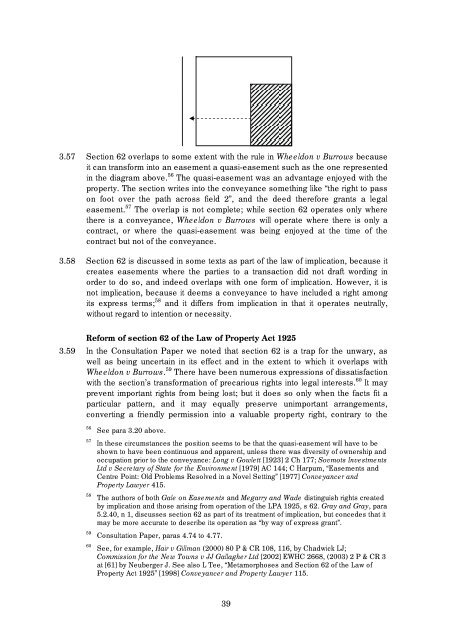Making Land Work: Easements, Covenants and ... - Law Commission
Making Land Work: Easements, Covenants and ... - Law Commission
Making Land Work: Easements, Covenants and ... - Law Commission
Create successful ePaper yourself
Turn your PDF publications into a flip-book with our unique Google optimized e-Paper software.
3.57 Section 62 overlaps to some extent with the rule in Wheeldon v Burrows because<br />
it can transform into an easement a quasi-easement such as the one represented<br />
in the diagram above. 56 The quasi-easement was an advantage enjoyed with the<br />
property. The section writes into the conveyance something like “the right to pass<br />
on foot over the path across field 2”, <strong>and</strong> the deed therefore grants a legal<br />
easement. 57 The overlap is not complete; while section 62 operates only where<br />
there is a conveyance, Wheeldon v Burrows will operate where there is only a<br />
contract, or where the quasi-easement was being enjoyed at the time of the<br />
contract but not of the conveyance.<br />
3.58 Section 62 is discussed in some texts as part of the law of implication, because it<br />
creates easements where the parties to a transaction did not draft wording in<br />
order to do so, <strong>and</strong> indeed overlaps with one form of implication. However, it is<br />
not implication, because it deems a conveyance to have included a right among<br />
its express terms; 58 <strong>and</strong> it differs from implication in that it operates neutrally,<br />
without regard to intention or necessity.<br />
Reform of section 62 of the <strong>Law</strong> of Property Act 1925<br />
3.59 In the Consultation Paper we noted that section 62 is a trap for the unwary, as<br />
well as being uncertain in its effect <strong>and</strong> in the extent to which it overlaps with<br />
Wheeldon v Burrows. 59 There have been numerous expressions of dissatisfaction<br />
with the section’s transformation of precarious rights into legal interests. 60 It may<br />
prevent important rights from being lost; but it does so only when the facts fit a<br />
particular pattern, <strong>and</strong> it may equally preserve unimportant arrangements,<br />
converting a friendly permission into a valuable property right, contrary to the<br />
56 See para 3.20 above.<br />
57 In these circumstances the position seems to be that the quasi-easement will have to be<br />
shown to have been continuous <strong>and</strong> apparent, unless there was diversity of ownership <strong>and</strong><br />
occupation prior to the conveyance: Long v Gowlett [1923] 2 Ch 177; Sovmots Investments<br />
Ltd v Secretary of State for the Environment [1979] AC 144; C Harpum, “<strong>Easements</strong> <strong>and</strong><br />
Centre Point: Old Problems Resolved in a Novel Setting” [1977] Conveyancer <strong>and</strong><br />
Property <strong>Law</strong>yer 415.<br />
58 The authors of both Gale on <strong>Easements</strong> <strong>and</strong> Megarry <strong>and</strong> Wade distinguish rights created<br />
by implication <strong>and</strong> those arising from operation of the LPA 1925, s 62. Gray <strong>and</strong> Gray, para<br />
5.2.40, n 1, discusses section 62 as part of its treatment of implication, but concedes that it<br />
may be more accurate to describe its operation as “by way of express grant”.<br />
59 Consultation Paper, paras 4.74 to 4.77.<br />
60 See, for example, Hair v Gillman (2000) 80 P & CR 108, 116, by Chadwick LJ;<br />
<strong>Commission</strong> for the New Towns v JJ Gallagher Ltd [2002] EWHC 2668, (2003) 2 P & CR 3<br />
at [61] by Neuberger J. See also L Tee, “Metamorphoses <strong>and</strong> Section 62 of the <strong>Law</strong> of<br />
Property Act 1925” [1998] Conveyancer <strong>and</strong> Property <strong>Law</strong>yer 115.<br />
39
















